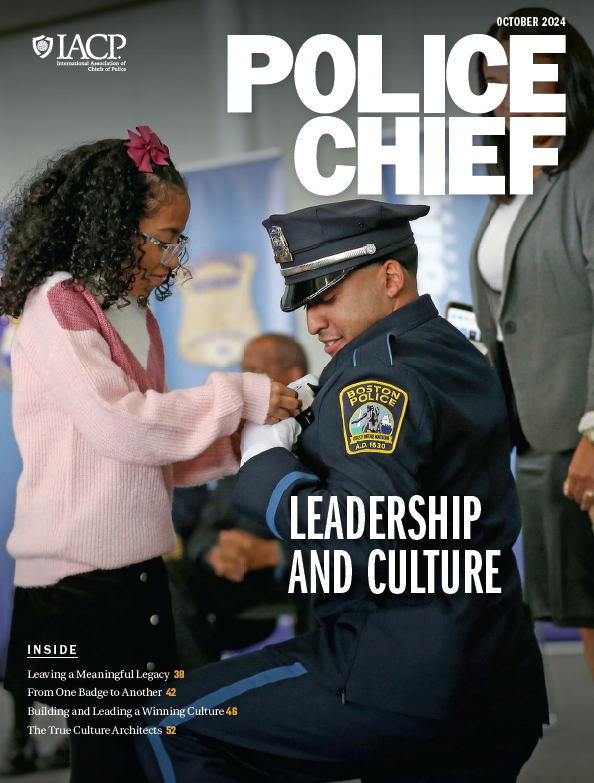Recruiting personnel is a continuous challenge for police organizations. Many U.S. state and local government employers identify policing positions as their most difficult to fill—more difficult than engineering, information technology, or firefighting and emergency medical services.1 Incidents such as the murder of George Floyd and subsequent protests accelerated the number of voluntary resignations from police departments and underscored the need to examine both external and internal influences on police staffing levels.2
To reduce staff turnover, some police agencies have increased salaries and offered other economic incentives.3 Of course, departments vary in their ability to increase financial compensation for officers. Complicating the staffing challenge is the demand for officers to better reflect the diversity of their communities or to have an increasing variety of skills. U.S. policymakers have sought to diversify police forces by race and sex for more than a half-century, with calls for doing so continuing over time.4 Communities may seek police officers with skills in physical agility, communications, critical and strategic thinking, information technology, or foreign languages.5 Such efforts would also require defining the diversity a community seeks and gauging how well the police department is progressing toward achieving it.6
Efforts to address police recruiting and other staffing questions may take ad hoc, piecemeal approaches, and fail to build on earlier efforts.7 However, by becoming a learning organization, a police agency can learn from and improve its recruitment efforts over time.
Recent Issues in Recruiting
Police agencies in recent years have faced several acute issues in recruiting. One recent article suggested a possible need for adjustments in appealing to the younger generations entering the workforce.8 Agencies may, for example, seek to appeal to younger workers by rebranding through social media, promoting agency features that overlap with younger workers’ desires, and gathering information on how an agency is perceived by its community. Implementing technology to help guide employees through the recruitment process may also help.
One recent analysis suggests preparing individual development plans for recruits to map their opportunities within the organization may assist the new officers in realizing their professional goals.9 Police agencies might also find ways to emphasize the personal benefits of a career in policing and with their specific police department.10 Periodic review of what has been learned from implementing specific recruitment strategies is essential to determining the best steps for future success.
Police agencies can also learn quantitative and qualitative lessons from their recruiting efforts and apply them to future ones.11 Quantitatively, agencies can benchmark their current efforts, set goals for future ones, develop a plan for meeting them, and identify and collect data most relevant to their efforts. Qualitatively, this may include gathering information on how candidates became interested in agencies, including what specifically attracted them. Understanding why candidates want to join an agency can inform future recruiting efforts. Similarly, agencies may wish to “screen in” individuals by targeting candidates with desired skills.12 They may also wish to find ways for officers, through personal associations, to reduce the “social distance” between the police agency and qualified female and minority candidates to help attract those individuals to policing.13
Quantitative and qualitative benchmarking can also be critical as agencies seek to become more diverse and inclusive—and to identify and define the diversity they most desire for their workforce.14 Agencies may best benefit from their diversity efforts when they view such efforts not as obligatory but as an opportunity to learn from all in their community and to spur innovation and improved culture in their workforce.15 Such efforts should consider that the recruits of today will be the agency leaders of tomorrow and hence affect the agency for years to come. Agencies should also build a two-way communication flow between supervisors/commanders and officers to best understand recruitment and retention issues, as well as to build a feedback loop. Agencies can benefit from both successful projects, which reassure officers of the importance of their work, and from unsuccessful ones, which allow officers to recalibrate their work.
Becoming a Learning Organization
Many recent lessons in recruiting note the need for agencies to learn from their efforts to improve upon them.

Improving agency culture can make an agency more attractive to recruits. Culture can underlie multiple elements (e.g., personal mastery, shared vision) that allow an organization to learn and evolve as needed.16 Within police organizations, culture can be set by leadership expectations, departmental sense of purpose, and professional growth and development opportunities.17 Police organizations that are slow to alter their cultures by changing recruitment processes, responding to what motivates recruits, or altering their leadership profile to better reflect the agency they wish to develop, may encounter difficulties in attracting capable people who reflect the demographic diversity of their communities or other desired workforce attributes.18
To achieve high performance in recruiting, police agencies need to go beyond improving their culture to become agencies that learn and implement lessons. They must become learning organizations, i.e., organizations whose personnel continually expand their capacity and develop new ways of thinking about and solving problems.19 Such organizations must also become adept at problem-solving, experimenting, learning from others and their own experience, and transferring knowledge.20 Learning organizations must continuously leverage information from their experience and translate it into lessons for operations that adapt to changing circumstances.
Efforts to facilitate learning organizations may occur both above and below an organizational team executing a mission.21 Above the team, organizational executives can provide strategic leadership for learning and connect the organization to its environment, as well as empower personnel to achieve the organizational vision and create systems to capture and share learning. Below the team, the organization should promote inquiry and dialogue among individuals and create continuous learning opportunities for them as well.
Habits of learning organizations can be particularly helpful in organizations that “tend to focus more on collaborative effort to achieve social outcomes” and where individuals and groups must “work jointly in a more complex ecosystem with many stakeholders and [financial] profit may not be the only measurement for success.”22 There is little that applies the concepts of learning organizations to public safety broadly construed. One possibly relevant example comes from forestry. Research on learning organizations led the U.S. Forest Service to establish a center for gathering and analyzing data on wildfires and applying the lessons to future operations.23 Police organizations can benefit from similar efforts to learn and implement lessons over time.24
The following discussion of the experience of the Charleston, South Carolina, Police Department in becoming a learning organization, particularly for recruiting, demonstrates how the concepts of a learning organization have been applied to one police agency. This includes defining the terms on which to measure progress, conducting baseline and ongoing measurements of that progress, adjusting efforts given the information from those measurements, and continuing a cycle of learning and improvement.
Charleston’s Experience as a Learning Organization
The Charleston Police Department (CPD) prides itself on being a learning organization, particularly in the domain of recruitment. A defining trait of CPD’s approach to recruitment lies in its foundational principle: hiring individuals who not only are highly professional and educated, but who possess nuanced soft skills and lived experiences that contribute to a compassionate approach to customer service in public safety. The department firmly believes that every individual who puts on the CPD uniform is not just an allocation number, but a valuable asset deserving appreciation and empowerment. The agency maintains the ethos that every officer has a voice and a perspective that can enrich the department’s mission.
“True progress cannot happen in isolation.”
The Recruitment and Retention Unit, supported by the overall organization, has constantly challenged established standards to assess if effective, evidence-based improvements could occur. Initially the unit took a deep dive into the agency’s hiring process. Through data collection across the application, testing, and onboarding phases, the unit crafted and refined marketing and recruiting strategies. These efforts allowed the unit to make effective administrative changes and improvements to the overall applicant journey.
CPD has also cultivated an environment where evidence-based policing practices are not just welcomed— they are encouraged. This cultural value has been embedded in the agency’s policy manual and propagated among personnel, illustrated by the fact that CPD houses three LEADS Scholars. Moreover, the department’s recent hiring of a procedural justice and research director signifies the department’s commitment to growth in learning and change. The procedural justice and research director role has been instrumental in fostering collaboration among different units and refining research and data tools that validate recruitment programs.
True progress cannot happen in isolation. The department has championed the value of sharing insights with other agencies, aiming for improvements locally that translate across a wider context. This spirit extends to the academic realm as well. CPD’s partnerships with researchers are intentional and selective. The department chooses academics and researchers who value the profession and treat officers as equal colleagues and partners in crafting meaningful solutions.
The chief and command staff also play an essential role in building and sustaining a learning organization. Chief Chito Walker has encouraged evidence-based innovation in recruitment since he served as captain over the unit in 2018. He has made a commitment to professional development, mentoring of staff, research-based decision-making, and expansive partnerships to ensure that CPD’s recruitment and retention efforts stay at the cutting edge of policing.
An agency cannot solve a hiring crisis focusing solely on recruitment. Retention is the key to many of the current police staffing challenges. Recently, through a partnership with the American Society of Evidence Based Policing Applied Criminology course, CPD Sergeant Anthony Gibson was able to collaborate with a CPD analyst and two academics from Kent State and the University of Cincinnati to survey CPD officers and conduct follow-up focus group interviews. Out of these efforts, the internal Strategic Management and Research Team (S.M.A.R.T.) was created to address four overarching themes in retention including valuing staff, officer wellness, transparent promotional processes, and open communication. This is just one example of how CPD is committed to translating evidence-based findings into operationalized initiatives.
Charleston is not perfect and always has room for growth. Charleston, like other agencies, can learn from researched and tested best practices. What should be noted is that the blueprint for CPD’s success as a learning organization is that the agency is willing to self-reflect, strives to foster a culture of continuous learning, and always prioritizes collaboration over isolation.
Application Lessons
As police organizations seek to become more evidence-based and improve their overall performance on measures they prioritize with their communities, they need to continually assess the efficacy of their operations and discover innovative strategies for implementation. While this is true for virtually all aspects of police administration, it is clearly evident for meeting workforce needs in today’s dynamic environment, especially for recruitment. Agencies can optimize this process by becoming learning organizations. Becoming a learning organization requires ongoing and critical inquiry of existing policies and processes, systematic collection and assessment of information and metrics, and continuous search for and implementation of new innovations and strategies. As evident from the Charleston experience, this means not just being open to change but cultivating and embracing it. Moreover, engaging the research literature and the larger profession can foster ideas for change and their implementation. 🛡
Notes:
1Police Executive Research Forum, The Workforce Crisis, and What Police Agencies Are Doing About It, 2019.
2Scott M. Mourtgos, Ian T. Adams, and Justin Nix, “Elevated Police Turnover Following the Summer of George Floyd Protests: A Synthetic Control Study,” Criminology & Public Policy 21, no. 1 (February 2022): 9–33.
3Amie M. Schuck and Cara E. Rabe-Hemp, “Investing in People: Salary and Turnover in Policing,” Policing: An International Journal 41, no. 1 (February 2018): 113–128.
4President’s Commission on Law Enforcement Administration and Justice, The Challenge of Crime in a Free Society (Washington, DC: U.S. Government Printing Office, 1967); President’s Task Force on 21st Century Policing, Final Report of the President’s Task Force on 21st Century Policing (Washington, DC: Office of Community Oriented Policing Services, 2015).
5International City/County Management Association, The Model Police Officer: Recruitment, Training, and Community Engagement (2018); James E. Copple, Law Enforcement Recruitment in the 21st Century: Forum Proceedings (Washington, DC: Office of Community Oriented Policing Services, 2017).
6Jeremy M. Wilson and Clifford A. Grammich, “Reframing the Police Staffing Challenge: A Systems Approach to Workforce Planning and Managing Workload Demand,” Policing: A Journal of Policy and Practice 18 (2024): 1-12.
7Wilson and Grammich, “Reframing the Police Staffing Challenge.”
8Ashley French et al., “Improving Recruitment: Strategies for Law Enforcement Agencies,” Police Chief Online, May 3, 2023.
9Colin May, “What’s the Plan? Using Development Plans as Recruitment and Retention Tools,” Police Chief Online, January 25, 2023.
10Elizabeth Linos, “More than Public Service: A Field Experiment on Job Advertisements and Diversity in the Police,” Journal of Public Administration Research and Theory 28, no. 1 (January 2018): 67–85.
11Ryan A. Durbin, “Data-Driven Diversity: How Leveraging Data Can Help Recruitment Strategies,” Police Chief 90, no. 4 (April 2023): 42–46.
12Brice Terpstra, Michael D. White, and Henry F. Fradella, “Finding Good Cops: The Foundations of a Screen-In (not Out) Hiring Process for Police,” Policing: An International Journal 45, no. 4 (2022): 676–692.
13Jennifer C. Gibbs, Jonathan Lee, and Baha Bachnak, “Low Police–Public Social Distance as the Key to Recruiting,” Policing: A Journal of Policy and Practice 14, no. 1 (March 2020): 181–190.
14Durbin, “Data-Driven Diversity”; Jeremy M. Wilson and Clifford A. Grammich, “Staffing Composition in Large, U.S. Police Departments: Benchmarking Workforce Diversity,” Policing: An International Journal of Police Strategies and Management 45, no. 5 (2022): 707–726.
15Anthony Gibson and Terry Cherry, “The Path to an Inclusive and Representative Agency,” Police Chief 90, no. 10 (October 2023): 36–39.
16Hong T. M. Bui, “Senge’s Learning Organization: Development of the Learning Organization Model,” in The Oxford Handbook of the Learning Organization, ed. Anders Ragnar Örtenblad (Oxford, UK: Oxford University Press, 2018), 35–50.
17Jocelyn Francis, “Creating a Culture of Success,” Police Chief 87, no. 4 (April 2020): 46–53.
18Catherine Rigaux and J. Barton Cunningham, “Enhancing Recruitment and Retention of Visible Minority Police Officers in Canadian Policing Agencies,” Policing and Society 31, no. 4 (2021): 454–482; Wilson and Grammich, “Reframing the Police Staffing Challenge.”
19Peter M. Senge, The Fifth Discipline: The Art and Practice of the Learning Organization (New York, NY: Doubleday, 1990).
20David A. Garvin, “Building a Learning Organization,” Harvard Business Review 71, no. 4 (July–August 1993): 78–91.
21Karen E. Watkins and Victoria J. Marsick, “Conceptualizing an Organization That Learns,” in The Oxford Handbook of the Learning Organization, ed. Anders Ragnar Örtenblad (Oxford, UK: Oxford University Press, 2018), 51–66.
22Siu Loon Hoe, “The Topicality of the Learning Organization: Is the Concept Still Relevant Today?” in The Oxford Handbook of the Learning Organization, ed. Anders Ragnar Örtenblad (Oxford, UK: Oxford University Press, 2018), 19–32.
23Patrick J. Healy, “Garvin’s Learning Organization: A Process Perspective on Learning for Implementation, Improvement, and Innovation,” in The Oxford Handbook of the Learning Organization, ed. Anders Ragnar Örtenblad (Oxford, UK: Oxford University Press, 2018), 67–86.
24Wilson and Grammich, “Reframing the Police Staffing Challenge.”
Please cite as
Jeremy. M. Wilson, Clifford A. Grammich, and Terry Cherry, “Becoming a Learning Organization for Recruitment,” Police Chief Online, February 21, 2024.



